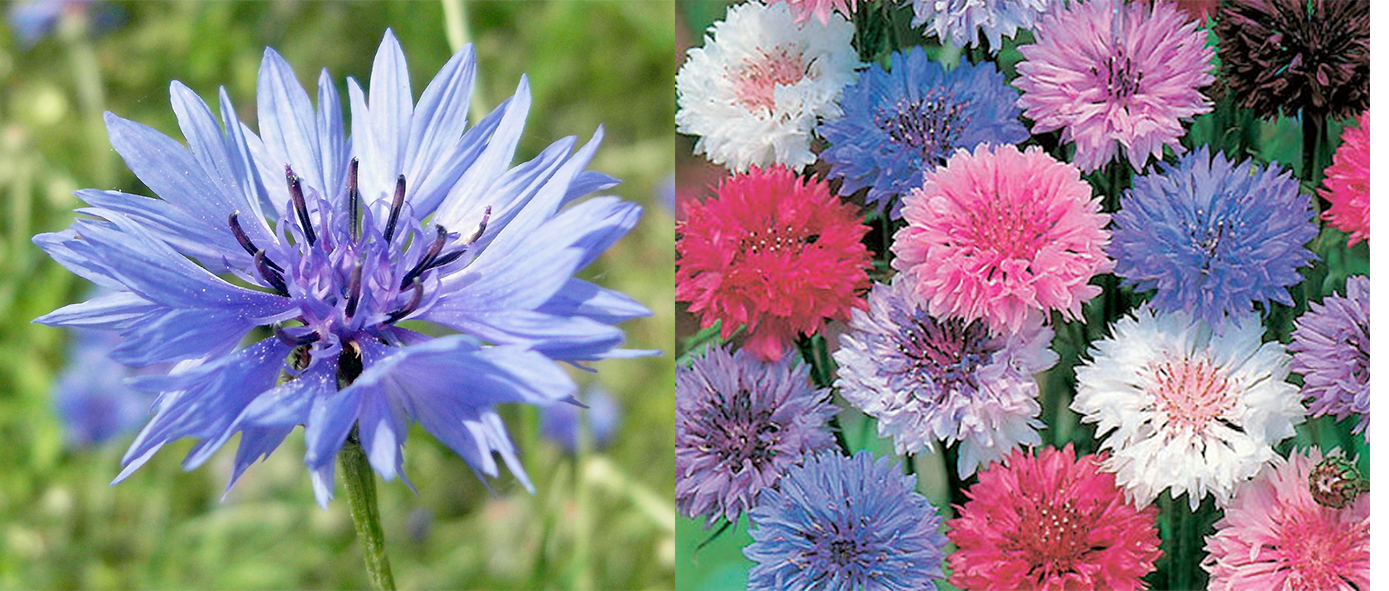 Cornflower,
Centaurea
cyanus flowers
with wild type
(left) and multiple
colours of garden
varieties *right)..
Cornflower,
Centaurea
cyanus flowers
with wild type
(left) and multiple
colours of garden
varieties *right)..
Welcome to the summary page for FabulousFusionFood's Edible Flowers guide to Cornflower along with all the Cornflower containing recipes presented on this site, with 3 recipes in total.
This is a continuation of an entire series of pages that will, I hope, allow my visitors to better navigate this site. As well as displaying recipes by name, country and region of origin I am now planning a whole series of pages where recipes can be located by meal type and main ingredient. This page gives a listing of all the Cornish recipes added to this site.
These recipes, all contain Cornflower as a major edible flower.
Centaurea cyanus, commonly known as cornflower or bachelor's button,[note 1] is an annual flowering plant in the family Asteraceae native to Europe. In the past, it often grew as a weed in cornfields, hence its name and can still be seen growing in the wild; though its much rarer than it was in the past.
Centaurea cyanus is an annual plant growing to 20–100 centimetres (8–39 in) tall, with grey-green branched stems. The leaves are lanceolate and 3–10 cm (1–4 in) long.[4] The flowers are most commonly an intense blue colour and arranged in flowerheads (capitula) of 1.5–3 cm diameter, with a ring of a few large, spreading ray florets surrounding a central cluster of disc florets. The blue pigment is protocyanin, which in roses is red. Fruit are approx. 3.5 mm long with 2–3 mm-long pappus bristles.[6] It flowers all summer.
It has been brought into cultivation as a garden flower and has been naturalised in many other parts of the world, including North America and parts of Australia. It was introduced to Britain, along with grain during the Iron Age.
The flowers of Centaurea cyanus can be eaten raw, dried or cooked.[29] Dried petals are used in foods, including in spices. Their main purpose is to add colour to food. There are cheeses or oils that contain raw petals. Petals can also be added to salads, drinks, or desserts for garnishing purposes in raw or dried form. Dried petals are also used in teas and other beverages. Blue cornflower petals are sometimes one of the ingredients in Lady Grey tea.
Cornflowers have a slightly sweet and spicy clove-like taste. They also crystallize well and so can also be used candied, like violets, for cake and pudding (dessert) garnishes. They're particularly good with rice pudding.
This is a continuation of an entire series of pages that will, I hope, allow my visitors to better navigate this site. As well as displaying recipes by name, country and region of origin I am now planning a whole series of pages where recipes can be located by meal type and main ingredient. This page gives a listing of all the Cornish recipes added to this site.
These recipes, all contain Cornflower as a major edible flower.
Centaurea cyanus, commonly known as cornflower or bachelor's button,[note 1] is an annual flowering plant in the family Asteraceae native to Europe. In the past, it often grew as a weed in cornfields, hence its name and can still be seen growing in the wild; though its much rarer than it was in the past.
Centaurea cyanus is an annual plant growing to 20–100 centimetres (8–39 in) tall, with grey-green branched stems. The leaves are lanceolate and 3–10 cm (1–4 in) long.[4] The flowers are most commonly an intense blue colour and arranged in flowerheads (capitula) of 1.5–3 cm diameter, with a ring of a few large, spreading ray florets surrounding a central cluster of disc florets. The blue pigment is protocyanin, which in roses is red. Fruit are approx. 3.5 mm long with 2–3 mm-long pappus bristles.[6] It flowers all summer.
It has been brought into cultivation as a garden flower and has been naturalised in many other parts of the world, including North America and parts of Australia. It was introduced to Britain, along with grain during the Iron Age.
The flowers of Centaurea cyanus can be eaten raw, dried or cooked.[29] Dried petals are used in foods, including in spices. Their main purpose is to add colour to food. There are cheeses or oils that contain raw petals. Petals can also be added to salads, drinks, or desserts for garnishing purposes in raw or dried form. Dried petals are also used in teas and other beverages. Blue cornflower petals are sometimes one of the ingredients in Lady Grey tea.
Cornflowers have a slightly sweet and spicy clove-like taste. They also crystallize well and so can also be used candied, like violets, for cake and pudding (dessert) garnishes. They're particularly good with rice pudding.
The alphabetical list of all recipes on this site follows, (limited to 100 recipes per page). There are 3 recipes in total:
Page 1 of 1
| Cornflower Shortbread Origin: Scotland | Edible Flower Salt Origin: Britain | White Chocolate and Cornflower Fudge Origin: America |
Page 1 of 1